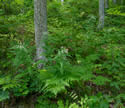Eupatorium sessilifolium (Upland Boneset)
| Also known as: | Upland Thoroughwort |
|---|---|
| Genus: | Eupatorium |
| Family: | Asteraceae (Aster) |
| Life cycle: | perennial |
| Origin: | native |
| Status: |
|
| Habitat: | part shade, shade; average to dry rocky or sandy soil; oak woods, forest edges, savanna, bluffs |
| Bloom season: | July - August |
| Plant height: | 2 to 4 feet |
| Wetland Indicator Status: | none |
| MN county distribution (click map to enlarge): |  |
| National distribution (click map to enlarge): |  |
Pick an image for a larger view. See the glossary for icon descriptions.
Detailed Information
Flower: 


![[photo of flower clusters]](/udata/r9ndp23q/jt/eupatorium-sessilifolium-15-t.jpg) Flat-topped branching clusters at the top of the stem and arising from the uppermost leaf axils. Flower heads are about 1/8 inch across, a few heads (commonly 3) at the tip of a short stalk, usually with 5 tiny flowers per head. Flowers are white, star-shaped with 5 triangular petals. In the center is a brown column of white-tipped stamens; styles are white, flattened, long and string-like.
Flat-topped branching clusters at the top of the stem and arising from the uppermost leaf axils. Flower heads are about 1/8 inch across, a few heads (commonly 3) at the tip of a short stalk, usually with 5 tiny flowers per head. Flowers are white, star-shaped with 5 triangular petals. In the center is a brown column of white-tipped stamens; styles are white, flattened, long and string-like.
![[close-up of flowers and phyllaries]](/udata/r9ndp23q/jt/eupatorium-sessilifolium-07-t.jpg) The bracts (phyllaries) around the base of a flower head are in 2 or 3 layers, green, densely covered in white hairs, the set about ¼ inch (4.5 to 6.5 mm) long. Stalks are also covered in short hairs.
The bracts (phyllaries) around the base of a flower head are in 2 or 3 layers, green, densely covered in white hairs, the set about ¼ inch (4.5 to 6.5 mm) long. Stalks are also covered in short hairs.
Leaves and stems: 

![[photo of leaves]](/udata/r9ndp23q/jt/eupatorium-sessilifolium-17-t.jpg) Leaves are opposite, 3 to 6 inches (7 to 15 cm) long and to ~1 inch across, narrowly egg-shaped to lance-oblong, broadest at or near the base, rounded or straight across at the base, tapering to a pointed tip, and stalkless. Edges are shallowly toothed; surfaces are hairless and dotted with tiny glands.
Leaves are opposite, 3 to 6 inches (7 to 15 cm) long and to ~1 inch across, narrowly egg-shaped to lance-oblong, broadest at or near the base, rounded or straight across at the base, tapering to a pointed tip, and stalkless. Edges are shallowly toothed; surfaces are hairless and dotted with tiny glands.
![[close-up of mid-stem leaf node]](/udata/r9ndp23q/jt/eupatorium-sessilifolium-04-t.jpg) The leaf bases of opposite pairs sometimes overlap but do not clasp the stem. Stems are single, erect to ascending, unbranched except near the flowers, hairy on the upper stem and hairless below.
The leaf bases of opposite pairs sometimes overlap but do not clasp the stem. Stems are single, erect to ascending, unbranched except near the flowers, hairy on the upper stem and hairless below.
Fruit: 
Fruit is a dark seed 2 to 3 mm long with a tuft of white hair to carry it off in the wind.
Notes:
Upland Boneset is rare in Minnesota, where it reaches the northwestern fringe of its range in the southeast corner of the state. According to the DNR, only a handful of populations have been found after extensive biological surveys in the area. Its preferred oak woods habitat is under pressure from incompatible land uses, development and logging in particular, with added risks from invasive species such as buckthorn and garlic mustard. It was listed as a Threatened species in 1996, and is currently Special Concern in Wisconsin.
While the flower clusters resemble those of related Eupatorium species, the leaves set this one apart. Tall Boneset (E. altissimum) is most similar; it also has stalkless leaves but they are widest at or above the middle, tapering to a narrowed base. The flowers of White Snakeroot (Ageratina altissima) are superficially similar, but its leaves are more broadly egg-shaped, sharply toothed, and are distinctly stalked.
There are 2 or 3 vars of E. sessillifolium, but these are not universally accepted and the distinctions are not well documented. The DNR lists var. brittonianum in Minnesota.
Native Plant Nurseries, Restoration and Landscaping Services ↓
More photos
Photos by John Thayer taken in Houston County.
Comments
Have you seen this plant in Minnesota, or have any other comments about it?







 Upland Boneset plant
Upland Boneset plant Upland Boneset plant
Upland Boneset plant Upland Boneset habitat
Upland Boneset habitat